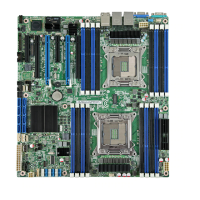Functional Architecture Overview Intel® Server Board S2600CO Family TPS
24 Revision 1.4
Intel order number G42278-004
8Rx4
(QDP)
32G 64G 1066 1066 1066 1066
3.2.2.2 Memory Slot Identification and Population Rules
Note: Although mixed DIMM configurations may be functional, Intel
®
only performs platform
validation on systems that are configured with identical DIMMs installed.
Each installed processor provides four channels of memory. On the Intel
®
Server Board
S2600CO each memory channel support 2 memory slots, for a total possible 16 DIMMs
installed.
System memory is organized into physical slots on DDR3 memory channels that belong
to processor sockets.
The memory channels from processor socket 1 are identified as Channel A, B, C and D.
The memory channels from processor socket 2 are identified as Channel E, F, G, and H.
Each memory slot on the server board is identified by channel and slot number within
that channel. For example, DIMM_A1 is the first slot on Channel A on processor 1;
DIMM_E1 is the first DIMM socket on Channel E on processor 2.
The memory slots associated with a given processor are unavailable if the
corresponding processor socket is not populated.
A processor may be installed without populating the associated memory slots provided a
second processor is installed with associated memory.
In this case, the memory is
shared by the processors.
However, the platform suffers performance degradation and
latency due to the remote memory.
Processor sockets are self-contained and autonomous. However, all memory subsystem
support (such as Memory RAS, Error Management,) in the BIOS setup is applied
commonly across processor sockets.
The BLUE memory slots on the server board identify the first memory slot for a given
memory channel.
DIMM population rules require that DIMMs within a channel be populated starting with the BLUE
DIMM slot or DIMM farthest from the processor in a “fill-farthest” approach. In addition, when
populating a Quad-rank DIMM with a Single- or Dual-rank DIMM in the same channel, the
Quad-rank DIMM must be populated farthest from the processor. Intel
®
Memory Reference
Code (MRC) will check for correct DIMM placement.
On the Intel
®
Server Board S2600CO a total of 16 DIMM slots is provided (2 CPUs – 4
Channels/CPU, 2 DIMMs /Channel). The nomenclature for DIMM sockets is detailed in the
following table:
Table 6. Intel
®
Server Board S2600CO DIMM Nomenclature
Processor Socket 1 Processor Socket 2
(0)
Channel A
(1)
Channel B
(2)
Channel C
(3)
Channel D
(0)
Channel E
(1)
Channel F
(2)
Channel G
(3)
Channel H
A1 A2 B1 B2 C1 C2 D1 D2 E1 E2 F1 F2 G1 G2 H1 H2

